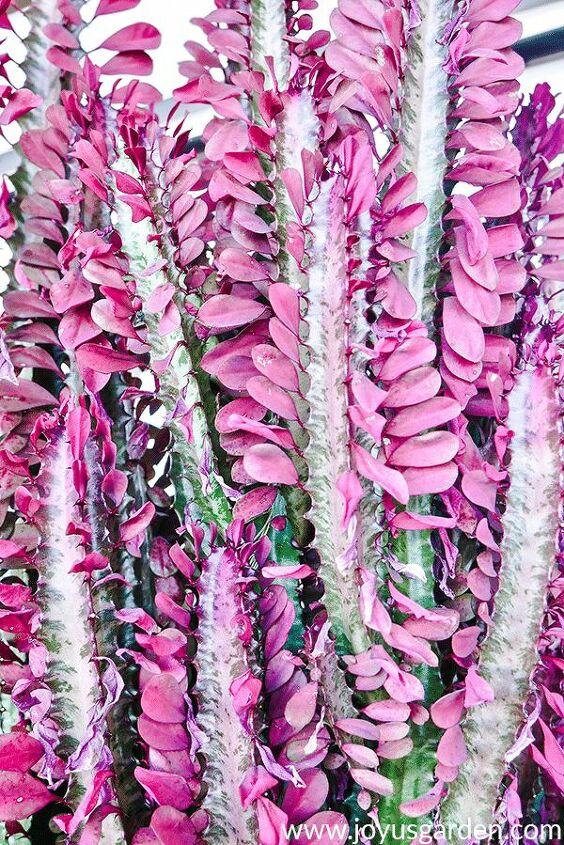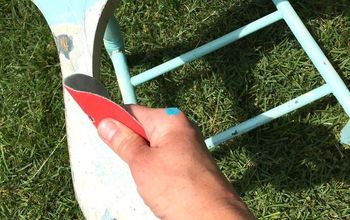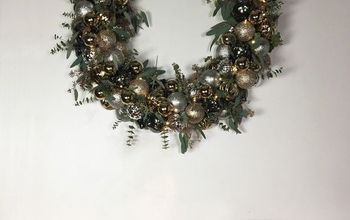Repotting A Euphorbia Trigona: The Mix To Use & a Good Trick To Know

Here's everything you need to know about repotting a Euphorbia trigona; whether growing as a houseplant or outdoors. This includes the best times to do it, the soil mix to use, the steps to take & things good to know.
My Euphorbia trigona rubra was growing like a weed and needed a bigger base to keep it in proportion. It’s not that the roots were showing or coming out of the drain holes but those stems sure were were getting taller and heavy. This is all about repotting a Euphorbia trigona including the mix to use, a useful trick and things good to know.
I’m transplanting a Euphorbia trigona rubra (I’ve also seen it labeled as red or royal red) but all of this applies to the Euphorbia trigona (which is solid green) and other varieties also. The common name for this popular succulent is African Milk Tree because of the milky sap that oozes out of it when broken or cut. Mine that you see here looks a little lack luster right now because it’s coming out of its semi-dormant winter state and is losing its leaves.
Spring or summer are the best times. I transplanted this 1 on March 4 but I live in Tucson, AZ. The temps have already warmed & the days are getting longer.
Materials used:
I use a mix locally produced here in Tucson. I now have the recipe & will be doing a DIY succulent & cactus mix tutorial soon. Here are online options: Bonsai Jack (this 1 is very gritty; great for those prone to overwatering!), Hoffman’s (this is more cost effective if you have larger containers but you might have to add pumice or perlite) , or Superfly Bonsai (another fast draining 1 like Bonsai Jack great for indoor succulents).
I’m partial to Ocean Forest because of its high quality ingredients. Euphorbias like to a bit more moisture than do cacti. For this reason I add a couple of handfuls of potting soil (more if this was a bigger plant) in with the succulent & cactus mix. I’m in a sunny, hot & dry climate (Tucson, AZ) so this does the trick for my euphorbias. You can skip this if you tend to be heavy with the watering can or don’t think yours will be drying as quickly as mine.
This is my favorite amendment, which I use sparingly because it’s rich. I’m currently using Worm Gold Plus.
This jute twine string is very similar to what I use & handy for all sorts of things.
Steps to repotting a Euphorbia trigona:
This is the step I started with. My rubra isn’t that tall so I tied it in 3 places; top, middle & bottom. This keeps those heavy stems from flip flopping over & possibly breaking when you do the transplanting/repotting.
The less you handle this plant when you’re repotting it, the better.
Unless it’s terribly root bound, it should slide right out. The plant emits a sap when cut or broken which is irritating to some (more on that below) so you don’t want the stems to snap if you can help it. I handle Euphorbias gingerly so this doesn’t happen.
A single or double layer of newspaper will work just fine too. The succulent & cactus mix is very light so this will prevent too much of the mix from escaping but still allows for the water to drain out.
I mixed in a couple of handfuls of potting soil & compost along with the s & c mix.
Sprinkle in 1/4″ layer of worm compost when you’re close to the top. Top off with succulent & cactus mix as needed.
The root ball of my plant was on the smallish side so I pressed down around it to help hold the heavy stems up.
Since I filmed the video, 1 stem fell out of the pot & snapped at the base (propagation post coming soon!). I staked up another stem which looked like it might fall out & loosely tied all the stems together around the middle. I wanted to tell you this as a warning that you may have to stake & tie yours up too while it’s rooting in.
After Care
The Euphorbia trigona is back in its spot in my kitchen. It’s 4′ away from a sliding glass & 8′ away from a skylight getting lots of bright, natural light but no direct sun. I’m letting it settle in for at least 2 weeks before I thoroughly water it. The root ball was a bit damp & the temps aren’t climbing above 75F yet so that’ll be fine.
I’ll top it with a 1/4 – 1/2″ layer of compost once the mix starts to sink a bit (due to the weight of the stems). I’ll be doing a care post & video on Euphorbia trigona within the next few months so stay tuned for that.
Good To Know
I’m starting with this 1 because it’s important.
Keep it away from your face, especially the eyes, nose & mouth. It’s never irritated me but I always wear gloves when working with this plant.
Even though these succulents like a touch more moisture than do cacti, they’re subject to root rot.
I used jute twine but ribbon or a thin rope would work also. Those heavy stems easily fall over, especially when they get taller.
This plant has tiny thorns. They won’t rip your hand open but be mindful of them.
An established plant with many stems will weigh a lot. You’ll need a set of extra hands to help you out with the repotting.
You may need to stake your plant after the repotting. I ended up staking 1 of the stems & tying it up in the middle.
My Euphorbia trigona grows as a houseplant but it can be grown outdoors year round in temperate climates. If you’re in a hot, dry climate like I am, then I’d recommend adding a bit of potting soil to the mix.
It’ll stay in this marigold colored ceramic pot for at least a couple of years because the root ball has plenty of room to grow. I’ll go up a 1 pot size as the plant gets taller because aesthetically it’ll need a bigger base in proportion to its height.
A Euphorbia trigona is a fun, and low maintenance houseplant which does well if you have enough light. And, they do well outdoors year round in temperate climates. Repotting a Euphorbia trigona isn’t hard at all but it does take a bit of care and finesse, especially if you’re doing it for the 1st time.
Enjoyed the project?

































Frequently asked questions
Have a question about this project?